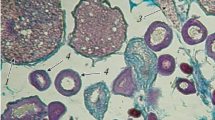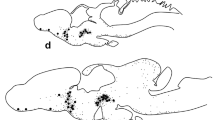Summary
-
1.
The anatomy and histology of the retro-cerebral endocrine system of female larvae of the antMyrmica have been described, and changes during development assessed from both aspects. These morphological and histological changes are comparable with those described in other groups of insects.
-
2.
These anatomical and histological changes have been related to a critical developmental stage in the larva, which can be defined by developmental markers (imaginal rudiments).
-
3.
This stage is critical since larvae reaching it may either developomit towards pupation or become dormant, in which case development is temporarily halted.
-
4.
It appears that in larvae reaching this stage neurosecretion may occur at one (whereupon larvae develop, via non-dormancy) or may be postponed (larvae become dormant).
-
5.
The condition of dormancy in these larvae can be recognised by examination of developmental markers alone, without further experimentation.
Zusammenfassung
-
1.
Die Anatomie und Histologie des innersekretorischen Systems (Prothorax-Drusen, corpora allata und neurosekretorische Zellen des Gehirns) der weiblichen Larven der AmeiseMyrmica sind beschrieben worden und Veränderungen während des Entwicklungsprozesses sind von beiden Gesichtspunkten aus bewertet worden. Diese morphologischen und histologischen Veränderungen können mit denen in anderen Insektengruppen verglichen werden.
-
2.
Diese anatomischen und histologischen Veränderungen sind mit einer kritischen, durch die Grösze der Anlagen feststellbaren Etappe in der Larvenentwicklung in Beziehung gebracht worden.
-
3.
Diese Etappe ist kritisch, weil die Larven, welche sie erreichen, sích entweder zu Puppen entwickeln können oder ruhen, in welchem Falle ihre Entwicklung vorubergehend aufgehalten wird.
-
4.
Es scheint, dasz bei Larven, welche diese Etappe erreichen, die Neurosekretion sofort eintreten kann (in welchen Falle die Entwicklung der Larven uber den Zustand der Nichtruhe vor sich geht), oder, dasz die Neurosekretion verschoben werden kann (d.h. die Larven ruhen).
-
5.
Der Zustand der Ruhe kann bei diesen Larven durch Anlagen ohne weitere Experimente festgestellt werden.
Résumé
L'anatomie et l'histologie du système endocrine rétro-cérébral de la larve femelle de la fourmiMyrmica ont été décrites, et les changements en cours de développement ont été évoqués sous ces deux aspects. Ces changements morphologiques et histologiques sont comparables à ceux constatés chez d'autres groupes d'Insectes.
Ces changements ont été mis en corrélation avec un stade critique de développement chez la larve; il peut être indiqué par l'état des disques imaginaux.
Cette étape est critique car les larves qui l'atteignent peuvent, ou bien continuer leur évolution normale vers la pupaison, ou bien subir un arrêt temporaire de développement.
Il semblerait que chez les larves arrivées à cette étape, la neurosécrétion peut se produire immédiatement (la larve se développe alors sans interruption) ou être retardée (les larves passent alors à l'état de vie ralentie).
On peut reconnaître l'état de vie ralentie chez ces larves en examinant les disques imaginaux sans entreprendre d'expériences supplémentaires.
Similar content being viewed by others
References
1951.Brian (M. V.). — Summer population changes in colonies of the antMyrmica (Physiol. comp. et œcol.,2, 248–262).—Brian (M. V.). 1954. Studies on caste differentiation inMyrmica rubra L. I. The growth of queens and males (Insectes sociaux,1, 101–122).—Brian (M. V.. 1955.a. Studies on caste differentiation inMyrmica rubra L. II. The growth of workers and intercastes (Insectes sociaux,2, 1–34).—Brian (M. V.) 1955b. Studies on caste differentiation inMyrmica rubra L. III. Larval dormancy, winter size and vernalisation (Insectes sociaux,2, 85–114).
1949.Brian (M. V.), Brian (A. D.). — Observations on the taxonomy of the antsMyrmica rubra L. andM. laevinodis Nylander (Hymenoptera: Formicidae) (Trans. R. ent. Soc. Lond., 100, 393–409).—Brian (M. V.), Brian (A. D.). 1955. On the two forms macrogyna and mirogyna of the antMyrmica rubra L. (Évolution,9, 280–290).
1948.Cazal (P.). — Les glandes endocrines rétro-cérébrales des insectes (Bull. biol., Suppl.,32, 1–227).
1942.Hanström (B.). — Die corpora cardiaca und corpora allata der Insekten (Biol. Gen.,15, 485–531).
1899.Janet (C.). — Sur les nerfs céphaliques, les corpora allata et le tentorium de la Fourmi (Myrmica rubra L.) (Mem. Soc. Zool. Fr.,12, 295–335).
1954.Myser (W. C.). — The larval and pupal development of the honey beeApis mellifera, Linnaeus (Ann. ent. Soc. Amer.,47, 683–711).
1913.Nabert (A.). — Die Corpora Allata der Insekten (Z. wiss. Zool., 104, 181–358).
1935.Snodgrass (R. E.). —The Principles of Insect Morphology (1st edition, New York).
1947.Steedman (H. F.). — Ester wax; a new embedding medium (Quart. J. micromit. Sci.,88, 123–133).
1958.Weir (J. S.). — The effect of temperature variation on queen oviposition and colony foundation inMyrmica (J. ins. Physiol.,1, 352–360).—Weir (J. S.) 1959a. Egg masses and early larval growth in the antMyrmica (Insectes sociaux, 6 (in press).—Weir (J. S.) 1959b. Interrelation of queen and worker oviposition in the antMyrmica (Physiol. Zool., 63–77).—Weir (J. S.). 1959c. The influence of worker age on trophogenic larval dormancy in the antMyrmica (Insectes sociaux, 6 (in press).
1935.Weyer (F.). — Ueber drusenartige Nervenzellen im Gehirn der Honigbienen,Apis mellifica (Zool. Anz.,112, 137–141).
Author information
Authors and Affiliations
Rights and permissions
About this article
Cite this article
Weir, J.S. Changes in the retro-cerebral endocrine system of larvae ofMyrmica, and their relation to larval growth and development. Ins. Soc 6, 375–386 (1959). https://doi.org/10.1007/BF02225782
Issue Date:
DOI: https://doi.org/10.1007/BF02225782




